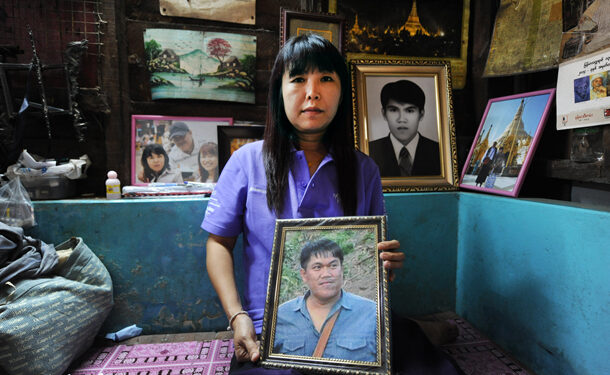The widow of slain journalist Aung Kyaw Naing is unconvinced by a report by the Myanmar National Human Rights Commission (MNHRC) concluding that her late husband was not tortured by the Burma Army before being shot dead in its custody.
In early October, Aung Kyaw Naing, who is also known by the name Par Gyi, was killed by the Burma Army in the country’s conflict-affected Mon State. The military waited several weeks to announce his death, claiming that he was arrested for his affiliation with insurgents and was fatally shot while attempting to reach for a firearm and flee detention. The incident sparked domestic and international outrage; US President Barack Obama said recently that he believed Par Gyi had been “tragically and senselessly murdered.”
In late October, President Thein Sein ordered an investigation by the MNHRC, which has just released the findings of its month-long inquiry.The Irrawaddy visited Ma Thandar at her Rangoon home, where she spoke about the integrity of the commission’s report.
Question: The Myanmar Human Rights Commissionhas concluded that Par Gyi was not tortured while being held captive by the Burma Army. Having witnessed the exhumation of his body, do you believe that he was tortured?
Answer: Yes. I am not an expert, but I could see that his ribs were broken. His forearms were also broken. There are also two types of torture: physical and psychological. I have reasons to believe that he was tortured.
The report [by the MNHRC] was fabricated; there are a lot of conflicting points [between their findings and the military’s statements]. The military has not been clear about where he was arrested. Their statement said that he was arrested at a riverside port, and that his clothing was wet. The report now says that he was arrested in Se Lan Wan, the downtown area of Kyaikmayaw Township, which means he was arrested within a municipal area.
If that is the case, no matter what, he must be charged under laws of the municipal administration. It must be reported to the police and he must be remanded in custody by a court. He must be released if not arraigned within 24 hours. If arraigned, he would need to be brought to trial.
The military had taken him against all of those procedures, which is a violation of human rights. That is psychological torture.
Q: Is there any evidence that you have gathered independently that is not mentioned in the commission’s report?
A: I have witness testimonies and video files. Forensic specialist Dr. Aung Soe, of the University of Medicine 2, said that Ko Par Gyi’s murder was unusual among the others he had seen. He said that he was shot point-blank from the chin. I asked him why, if he was shot in the head, his skull was not blown open. He said that it was because he was shot through the chin—so the bullet would not blow up the head, but would exit through the face. He said that the gun could not have been held up against his chin like that if he were in a fight.
There were two doctors conducting the forensic tests, Dr. Aung Soe and Dr. Khin Maung Oo. Dr. Aung Soe explained this verbally, not in writing, after the examination. We have a video record of this.
There were a total of five bullet wounds. A shot in the chin is fatal, so why were there five shots? If he had already been shot four times, how could he grab a gun? [The military has said that Par Gyi was shot while attempting to reach for a weapon.]
These are the questions. I have a lot of doubts. I have ample evidence and the truth is on our side.
Q: Are there other inconsistencies between the report and what you believe happened to Par Gyi?
A:Yes. The military considered him an armed insurgent, but [the commission] said that it was not sure whether Ko Par Gyi was a reporter or an insurgent at the time of his arrest. In fact, I submitted evidence long ago that he was a freelance reporter. There should have been no doubt about it.
It should be mentioned that some statements from the military are different from the findings of the commission. The military said that Ko Par Gyi grabbed and gun and ran away, but the commission’s report said the gun went off as he was locked in fighting [with a soldier]. So there’s a huge difference between those two accounts. The military’s said that he was a member of the DKBA/KKO [the Democratic Karen Benevolent Army and its political wing,Klohtoobaw Karen Organization].The commission report says that he was also a member of ABSDF [the All Burma Students’ Democratic Front, another armed insurgent group].
Q: A full 10 pages of the commission’s 16-page report were dedicated to fighting between rebels and government troops in the area where your husband was arrested. Why do you think the commission’s inquiry concentrated so heavily on the conflict?
A: Before the report was released, Commander-in-Chief [Snr-Gen Min Aung Hlaing] said during an interview with VOA [Voice of America] that the military considers anyone caught in that area to be an enemy. It was like he was trying to justify this. If he was considered an enemy just because he was there, what about all of the locals? Are they all enemies of the military?
I think the report focused on that because that is what the military is focusing on. The military will probably cite the report in court.
















